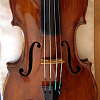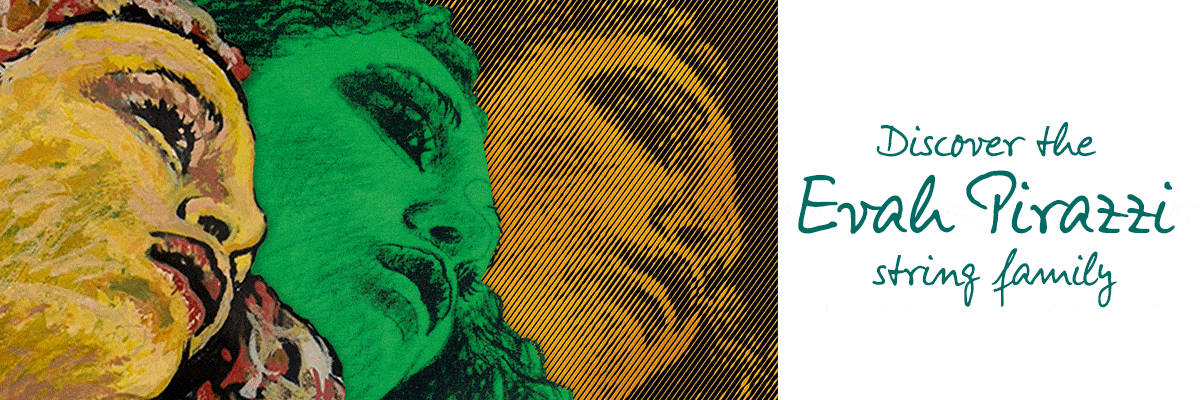
July 2009
V.com weekend vote: What gender is your fiddle, or does it have one?
July 31, 2009 20:08
For many of us, the violin is a kind of lifetime companion, and it takes on almost human dimensions in our lives.
Some people feel almost wedded to their instrument, like it is a kind of spouse, and think of it as having the gender a spouse for them would. Others think about the fact that the instrument can hit such high notes and thus see it as "female." On the other hand, a fiddle with a dark tone, or a viola, might be thought of as "male."
As for me, I'm fairly gender-neutral with my fiddles, but I'd probably think of each one that I own differently. The German, a family heirloom, I think of as male, carrying the family name ("Geiger") that my orphan grandmother didn't get to keep. The young American that's so cheery and yellow, though dark and mellow, it's actually female. The Italian is the balanced one, it's both.
Do you ever think of your violin in terms of gender? Please vote below, and share your thoughts!
V.com weekend vote: Should recording companies make mixes of classical music that are suitable for listening in the car or train?
July 24, 2009 04:21
I love my pianissimos as much as the next person, but...
I also like listening to music in the car. In fact, my family has been driving many miles across the United States this month, and I've wanted to listen to classical music. Unfortunately, it doesn't always work well.
Why? Because I can hear the music for a few minutes, and then it disappears. The ambient noise of a car (or for that matter, a restaurant or store) covers much of the quieter portions of the music , so one hears only an odd, occasional swoop of music, surrounded by long periods of, seemingly, silence.
At a live performance, the quieter portions of classical music can be thrilling. For that matter, I enjoy the full range of dynamics when listening on headphones, or in a silent room.
But if I'm to listen to classical music in the car, I need to fiddle constantly with the volume, or to keep the music going in my head when it disappears. This has made me wonder, with today's excellent technology, couldn't there be a way to include a version of classical recordings that is mixed specifically for use in the car, or in situations that have ambient noise? Wouldn't this help classical music radio stations as well? Or do people find this idea to be too much of a compromise?
V.com weekend vote: Which poses the greatest challenge for you, the right hand or the left?
July 17, 2009 19:06
This question occurred to me when yet another person discovered I was left-handed, and thus I was asked for the millionth time, "So do you play the violin left-handed?"
I had to suppress an almost violent urge to bellow, "WHAT? WHY on EARTH would I even think of doing that?"
I suppose I'm so left-handed that, during my early years on the violin, I barely even thought about right hand's role at all. It's all a matter of working out the fingerings, and developing vibrato, right?
Wrong. One quickly bumps into a wall with this mentality. After a while, my right hand needed serious work, and actually today while I was traipsing around Indiana University (part of the epic family road trip) I saw my former violin teacher, Henryk Kowalski, the one who made me play open strings until my right hand got the message. My right hand is still the one that requires the most daily discipline: keeping the martele, the spiccato, etc., in shape.
BTW, if you want to rock your own world, or see what a beginner goes through, just try switching hands and playing something, anything, with the reverse set-up. Woohoo! (Okay, switch back, that was scary...)
So what are your thoughts on this matter? Which hand poses your biggest challenge? What have you discovered in your quest to build technique in each hand? Please vote and share your thoughts and ideas.
V.com weekend vote: How are your music reading skills?
July 10, 2009 22:39
Often people blame things like the Suzuki method for a music-reading deficiency; the idea being that because they learned for a while by rote, they simply never wished to learn another way.
I'd like to propose another reason why people sometimes develop a deficiency: they simply don't practice reading enough, whatever the method. You don't have to be a Suzuki student to have a good ear and to prefer "knowing how it goes" to decoding the written music. But if you seldom read music, you can't expect your music-reading to improve.
In my own experience, I have to say that being in a ton of youth orchestras helped me greatly, and even so, I don't feel like my reading skills were comfortably fluent until several years after I graduated from college and had been playing regularly in a professional orchestra.
Knowing theory certainly helps with reading, but I'd argue that nothing helps more than doing it, a lot. If you need to practice reading, get a reading book that is very do-able, not something that's at the edge of of your ability, but something that allows you to read and completely perfect a page or two every week and move on. Most students have repertoire that they learn to a level of perfection; taking weeks and even months to polish a piece. But they should also have a page-turner book; one which requires new reading every week. In addition, ideally, they should play in an orchestra or ensemble.
Like everything else we do on fiddle, reading takes lots and lots of practice. Where are you with your reading? And can we inspire you to do more, if you need to? Do you have any stories about learning to read, that might be of help to others who struggle? Or frustrations to vent?
V.com weekend vote: Strad or del Gesù?
July 3, 2009 16:00
Earlier this week, Philippe Quint confessed to being a Strad man, and that got me thinking: Strad or Guarneri del Gesù?
The "Stradivarius" label is the famous one, it graces so many knock-offs, and Stradivari is the one violin maker that is known by both musicians and people in the general public -- musical Muggles -- like my Mom. (Hi Mom!) But the del Gesù has captured the imaginations of so many artists; this just can't be denied.
Guarneri del Gesùs have the general reputation of being more sonorous than Strads but less finely crafted. They also are rarer, simply because del Gesù was less prolific than was Stradivari, who kept making fiddles (some 1,000 of them) up until he died at the age of 93. (del Gesù lived only half as long -- to the age of 46). The Stradivari Society estimates there are approximately 135 del Gesùs left in existence, compared to 650 Stradivari instruments.
Here is a list of some violinists who currently play Strads: Joshua Bell plays the 1713 "Gibson ex Huberman" Stradivarius; Janine Jansen plays the 1727 "Barrere" Strad; Gil Shaham plays the 1699 "Comtesse de Polignac" Strad...there are many more, and please feel welcome to mention these artists below.
Perhaps the most famous Strad is the Messiah -- considered such a fine specimen that it is not to be played!
And here are some violinists who currently play on del Gesùs: Rachel Barton Pine plays the 1742 “ex-Soldat” del Gesù; Midori plays the 1734 "ex-Huberman" del Gesù; Vadim Repin plays on the 1736 “Von Szerdahely” del Gesù. Again, feel free to add to this least, it is by no means complete.
Pinchas Zukerman plays a 1742 del Gesù, and last year he test drove another one, made in 1741, and bought for a record-breaking $3.9 million by Moscow lawyer Maxim Viktorov.
The most famous del Gesù is Il Cannone which was Paganini's favorite instrument, so named because of its powerful sound. In 1837 Paganini gave the fiddle to his native city of Genoa, where it still resides and is played once a month, and on special occasions.
Jascha Heifetz, if you are curious, had several Strads and a del Gesù: he owned the 1714 "Dolphin" Strad, the 1731 "Piel" Strad, the 1736 Carlo Tononi, and the 1742 "ex David" del Gesù. It is said that he preferred the del Gesù kept until his death.
So which would you vote for? And please, tell us why. What do you like about the sound? About the craftsmanship? Have you played either kind, and what have been your impressions?
More entries: June 2009
Violinist.com is made possible by...
Dimitri Musafia, Master Maker of Violin and Viola Cases
Johnson String Instrument/Carriage House Violins
Subscribe
Laurie's Books
Discover the best of Violinist.com in these collections of editor Laurie Niles' exclusive interviews.

Violinist.com Interviews Volume 1, with introduction by Hilary Hahn

Violinist.com Interviews Volume 2, with introduction by Rachel Barton Pine






